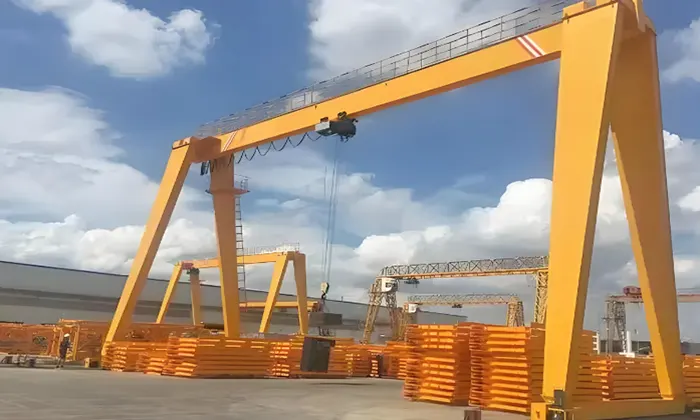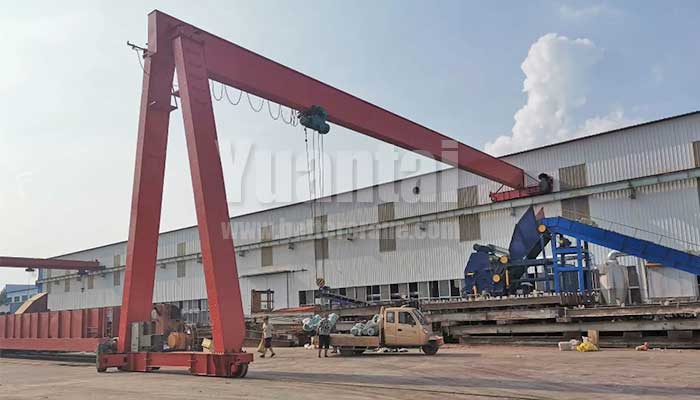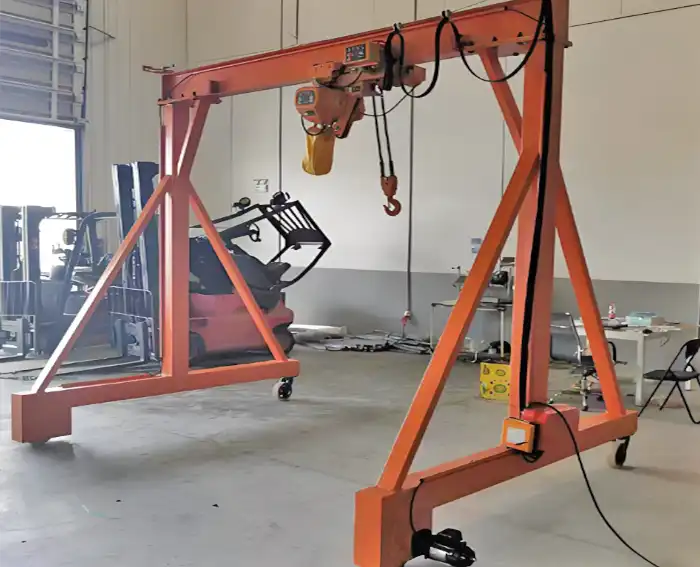Top Considerations for Buying 3 Ton Single Girder Gantry Cranes: Indoor vs Outdoor Use
Compare features needed for indoor applications (like in warehouses or assembly plants) and outdoor use (like construction sites or shipyards) to get right 3 ton gantry crane for your needs.
Overview of 3-Ton Single Girder Gantry Cranes
3-ton single girder gantry cranes are versatile lifting solutions designed to handle loads up to 3 tons efficiently. Featuring a single horizontal beam supported by two vertical legs, these cranes are ideal for various industrial applications. Their design allows for straightforward lifting and moving of materials within a workspace. The single girder structure makes them more cost-effective and simpler in design compared to double girder cranes, making them a popular choice for both indoor and outdoor use.
Importance of Selecting the Right Crane for Specific Environments
Choosing the right 3-ton single girder gantry crane is crucial because it directly impacts the crane's performance, safety, and durability. Indoor and outdoor environments present different challenges and requirements:
- Indoor Use: Cranes used indoors typically face less exposure to harsh environmental factors, such as extreme weather conditions. However, factors like space constraints and integration with existing warehouse systems become more significant. Selecting a crane that fits the available space and supports efficient workflow is essential.
- Outdoor Use: Cranes intended for outdoor environments must withstand elements such as rain, sun, and varying temperatures. They need to be built with durable materials and protective coatings to resist corrosion and weather-related wear and tear. Additionally, outdoor cranes should be robust enough to handle uneven surfaces and provide reliable performance in diverse conditions.
By understanding the specific needs of the environment in which the crane will be used, you can ensure optimal performance and longevity, avoiding potential issues related to weather damage or inadequate load handling.
Types of 3-Ton Gantry Cranes with Single Girder Designs
Single girder gantry cranes are versatile lifting solutions ideal for various applications where a 3-ton capacity is required. They come in several designs, each tailored to different operational needs and environments. Here are the main types of 3-ton single girder gantry cranes:
Single Girder Gantry Crane
Overview: Fixed single girder gantry cranes are mounted on a set of fixed supports and do not have the ability to move along the rail. They are commonly used in workshops, warehouses, and factories where the crane needs to serve a specific area.
Features:
- Stability: Fixed structure ensures high stability and load-bearing capacity.
- Cost-Efficient: Generally less expensive due to the simpler design and lack of mobility features.
- Applications: Ideal for permanent setups where movement is not required.
Advantages:
- Reliable and stable operation.
- Lower maintenance costs.
Disadvantages:
- Lack of mobility limits flexibility.
- Permanent installation restricts relocation.

Single Girder Semi Gantry Crane
Overview: Semi-mobile single girder gantry cranes are equipped with wheels or casters that allow them to be moved manually or with minimal assistance. This type is suitable for environments where occasional relocation within the facility is needed.
Features:
- Mobility: Can be moved within a limited area.
- Adjustability: Often includes adjustable height and width settings.
- Applications: Useful in facilities where reconfiguration of workspace is needed.
Advantages:
- Flexibility to move the crane as needed.
- Versatile for different operational layouts.
Disadvantages:
- Less stability compared to fixed models when moved.
- May require periodic realignment.

Portable Gantry Crane
Overview: Portable single girder gantry cranes are designed for easy transport and setup. They are often lightweight and equipped with features that allow quick assembly and disassembly.
Features:
- Portability: Lightweight and designed for easy transportation.
- Quick Setup: Can be assembled and disassembled quickly.
- Applications: Ideal for temporary projects or sites where cranes are needed for short-term use.
Advantages:
- High mobility and ease of transport.
- Suitable for diverse and temporary applications.
Disadvantages:
- Generally has lower load capacity and stability compared to fixed models.
- May require more frequent maintenance due to frequent relocation.
Adjustable Height Gantry Crane
Overview: Adjustable height single girder gantry cranes feature a design that allows for modification of the crane’s height to accommodate different lifting requirements. This type is suitable for applications where varying lifting heights are needed.
Features:
- Height Adjustment: Can be raised or lowered to meet specific needs.
- Flexibility: Provides adaptability for various load sizes and heights.
- Applications: Useful in environments with changing operational needs or multiple lifting heights.
Advantages:
- Versatile for different lifting tasks.
- Can handle a range of load sizes and heights.
Disadvantages:
- May have more complex assembly and maintenance requirements.
- Potentially higher cost due to adjustable features.
Indoor Applications
Features Required
Space Constraints In indoor environments such as warehouses or assembly plants, space can be limited. Therefore, 3-ton single girder gantry cranes need to have a compact design to fit within narrow aisles or tight areas. Additionally, adjustable height and width options can be crucial for accommodating different types of loads and optimizing the crane's use in various setups. This flexibility allows the crane to adapt to different operational needs and maximize the available space.
Weather Control Indoor cranes are generally shielded from extreme weather conditions, but they still require some protection from dust, dirt, and occasional moisture. Basic weather protection is often sufficient, such as simple enclosures or coverings that prevent debris from affecting the crane's operation. Since indoor environments offer controlled conditions, elaborate weatherproofing is usually unnecessary.
Portability Portability within an indoor facility is important for adapting to changing needs and layouts. Fixed gantry cranes may be suitable for permanent setups, but semi-mobile options with casters and wheels offer greater flexibility. These features allow the crane to be moved easily within the facility, facilitating reconfiguration of workspace or transport of materials to different areas.
Load Handling In indoor applications, the focus is on precision and smooth operation. The crane should be able to handle loads efficiently for tasks such as assembly, loading, and unloading. It is also important that the crane integrates well with other warehouse systems, such as conveyor belts or automated storage systems, to ensure a streamlined workflow and enhance overall productivity.
Corrosion Resistance While indoor cranes do not face severe environmental conditions, they still benefit from appropriate coatings and treatments to resist minor corrosion and wear. The emphasis is on maintaining the crane's appearance and functionality rather than addressing extreme corrosion threats. Regular maintenance ensures that the crane remains in good condition and continues to operate effectively over time.
Outdoor Applications
Features Required
Weather Protection Outdoor gantry cranes are exposed to a range of weather conditions, including rain, UV radiation, and extreme temperatures. Therefore, these cranes need full weather protection to ensure reliable performance and longevity. This protection typically includes weather-resistant coatings and enclosures that shield the crane’s components from moisture and sunlight. High-quality coatings prevent rust and degradation, while enclosures keep critical parts dry and functioning smoothly despite harsh weather.
Corrosion Resistance Corrosion resistance is a critical factor for outdoor cranes due to their constant exposure to environmental elements. These cranes are built with high-grade anti-corrosion materials and specialized coatings designed to withstand prolonged exposure to moisture and corrosive substances. Regular maintenance and inspections are essential to address any signs of wear or damage and ensure the crane’s continued effectiveness and safety. This proactive approach helps in preventing significant deterioration and extending the crane’s service life.
Portability Outdoor gantry cranes must be designed with robust mobility features to navigate various terrains, from paved surfaces to rough, uneven ground. Enhanced stability features are crucial to prevent tipping or instability during operation. This includes reinforced wheels or tracks and a solid base structure to maintain balance and support heavy loads. Portability also involves easy maneuverability to position the crane precisely where needed, even in challenging outdoor environments.
Load Handling The ability to handle large or bulky items in diverse outdoor conditions is a key requirement for outdoor gantry cranes. These cranes need to be capable of managing heavy loads efficiently, even on irregular surfaces or under less-than-ideal conditions. Features such as adjustable lifting heights, durable lifting mechanisms, and strong load-bearing capacities ensure that the crane performs effectively in various operational scenarios, including construction sites, shipyards, and other outdoor applications.
Comparative Analysis
Weather Protection
- Indoor: Minimal Requirements Indoor cranes typically face minimal exposure to harsh environmental factors. Therefore, weather protection for these cranes is relatively simple, often involving basic enclosures or coverings to guard against dust and occasional moisture. Since indoor environments are controlled, the focus is more on maintaining operational efficiency rather than extensive weatherproofing.
- Outdoor: Extensive Protection Needed Outdoor cranes require comprehensive weather protection due to constant exposure to rain, UV radiation, and extreme temperatures. This involves advanced weather-resistant coatings and full enclosures to shield the crane from environmental damage. Such extensive protection ensures that the crane remains functional and reliable despite the challenges posed by outdoor conditions.
Corrosion Resistance
- Indoor: Standard Protection For indoor use, standard corrosion protection is sufficient. This typically includes basic coatings and treatments that guard against light corrosion from dust or occasional spills. While still important, these measures are less intensive compared to outdoor requirements.
- Outdoor: Advanced Anti-Corrosion Measures Outdoor cranes need advanced anti-corrosion measures due to their exposure to harsh elements. High-grade anti-corrosion materials and specialized coatings are necessary to prevent rust and degradation from moisture and corrosive substances. Regular maintenance and inspections are crucial to ensure that these protections remain effective and the crane’s structural integrity is maintained.
Portability
- Indoor: Generally Less Demanding Portability requirements for indoor cranes are less demanding. These cranes may be equipped with casters or wheels for easy movement within the facility, but the conditions are generally more controlled. Fixed or semi-mobile designs are often sufficient for indoor use, allowing for adjustments as needed within a more stable environment.
- Outdoor: Must Handle Rough Conditions and Be Easily Maneuverable Outdoor cranes must be designed to handle rough and uneven terrains. This requires a robust design with reinforced wheels or tracks and enhanced stability features. The crane needs to be highly maneuverable to navigate various ground conditions and maintain stability while operating in challenging environments.
Cost Considerations
- Indoor: Lower Initial Cost Cranes designed for indoor use generally have a lower initial cost. This is due to the less stringent requirements for weather and corrosion protection, as well as simpler portability features. The focus on cost-efficiency often leads to lower overall expenses for procurement and installation.
- Outdoor: Higher Cost Outdoor cranes typically incur higher costs due to the need for advanced weatherproofing, corrosion resistance, and enhanced mobility features. The use of durable materials and specialized coatings contributes to the higher initial investment. However, these costs are offset by the crane’s ability to perform reliably in demanding outdoor conditions.
Additional Considerations
Safety Features
- Indoor: Basic Safety Measures Safety features for indoor gantry cranes typically include standard equipment such as emergency stop buttons, limit switches, and safety guards. These measures are designed to protect operators and prevent accidents within the controlled environment of a warehouse or assembly plant. Regular safety inspections and adherence to standard safety protocols are generally sufficient to maintain a safe working environment indoors.
- Outdoor: Enhanced Safety Features for Harsh Environments Cranes used outdoors require enhanced safety features due to the more challenging and unpredictable conditions. This includes additional safety measures such as reinforced structures to withstand high winds, rain, and extreme temperatures. Advanced features might also include anti-collision systems, enhanced load stability controls, and visibility aids like lighting and warning signals to ensure safe operation in diverse and potentially hazardous outdoor environments.
Maintenance Needs
- Indoor: Regular but Less Intensive Maintenance Indoor cranes typically require regular maintenance to ensure smooth operation and prevent minor issues. This maintenance is usually less intensive and involves routine tasks such as lubrication, inspections, and minor adjustments. The controlled indoor environment reduces the risk of severe wear and tear, making maintenance tasks more straightforward and less frequent.
- Outdoor: Frequent and Thorough Maintenance Outdoor cranes demand more frequent and thorough maintenance due to their exposure to harsher conditions. This includes regular checks for corrosion, wear and tear from weather exposure, and ensuring that all protective coatings and components are intact. Maintenance tasks are more intensive and involve detailed inspections, cleaning, and repairs to address issues caused by environmental factors. This proactive approach helps prevent potential failures and ensures the crane remains operational and safe over time.
Conclusion
When selecting a 3-ton single girder gantry crane, it is essential to consider the specific requirements of the environment in which it will be used:
- Weather Protection: Indoor cranes need minimal weather protection, focusing mainly on dust and moisture control. In contrast, outdoor cranes require extensive protection against rain, UV radiation, and extreme temperatures, necessitating robust coatings and enclosures.
- Corrosion Resistance: Indoor cranes benefit from standard corrosion protection, which is sufficient for less demanding environments. Outdoor cranes, however, need advanced anti-corrosion measures to withstand harsh environmental conditions, requiring high-grade materials and frequent maintenance.
- Portability: For indoor use, cranes generally need basic mobility features, such as casters or wheels for easy movement within the facility. Outdoor cranes must be designed to handle rough and uneven terrain, with reinforced mobility features to ensure stability and maneuverability.
- Safety Features: Indoor cranes can rely on basic safety measures, while outdoor cranes need enhanced safety features to address the risks associated with harsh environmental conditions.
- Maintenance Needs: Indoor cranes require regular but less intensive maintenance. Outdoor cranes demand more frequent and thorough maintenance due to their exposure to environmental elements and potential wear and tear.
Recommendations for Choosing the Right Crane Based on Application Needs
To select the most suitable 3-ton single girder gantry crane for your application, carefully evaluate the following factors:
- Assess Environmental Conditions: Determine whether the crane will be used indoors or outdoors. For indoor applications, focus on cranes with compact designs, basic weather protection, and standard corrosion resistance. For outdoor use, choose cranes with extensive weatherproofing, advanced corrosion resistance, and robust mobility features.
- Consider Safety and Maintenance: Ensure that the crane’s safety features are adequate for the environment and that you are prepared for the level of maintenance required. For outdoor cranes, be prepared for more frequent and detailed maintenance to keep the crane in optimal condition.
- Evaluate Portability Needs: Assess how important mobility is within your facility or site. Indoor cranes may require only basic portability features, while outdoor cranes need to be designed for maneuverability across various terrains.
By aligning the crane’s features with the specific needs of your environment and application, you can ensure optimal performance, safety, and longevity of your 3-ton single girder gantry crane.




